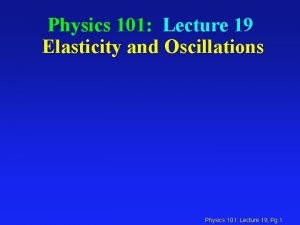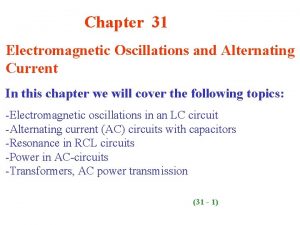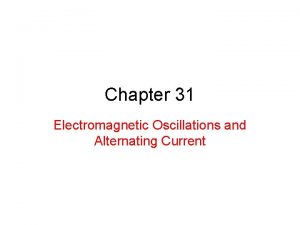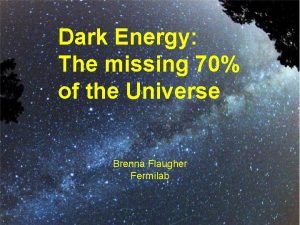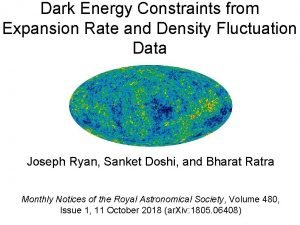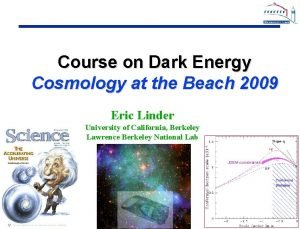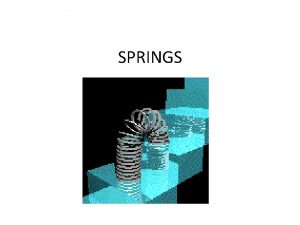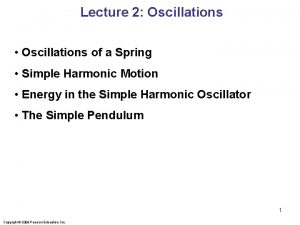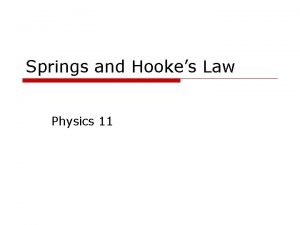Work and Energy Oscillations Oscillations of Springs Spring













- Slides: 13

Work and Energy Oscillations ©

Oscillations of Springs Spring problems are usually one of two types. They are either a force problem or an energy problem. The following example demonstrates two common spring problems. Energy Force m x 1 m x 2 x 0 = 0 m m m © RHJansen x 2

Example A mass m = 800 g is hung from a spring and lowered to equilibrium. The spring is displaced x 1 = 40 cm in the process. a. Draw the FBD for the mass Force Fs m Fs x 1 Fg m Fg © RHJansen

Example A mass m = 800 g is hung from a spring and lowered to equilibrium. The spring is displaced x 1 = 40 cm in the process. b. What is meant by term equilibrium ? Force Fs m Fs x 1 Fg The word equilibrium is a key word all year long. It means that something is equal. When the word equilibrium is used in this course it means that the forces are equal (balanced). m Fg © RHJansen

Example A mass m = 800 g is hung from a spring and lowered to equilibrium. The spring is displaced x 1 = 40 cm in the process. c. Ponder the answers to “a” and “b” and see if you can devise a way to solve for the spring constant k. Force Fs m Fs x 1 Fg m Fg © RHJansen

Example A mass m = 800 g is hung from a spring and lowered to equilibrium. The spring is displaced x 1 = 40 cm in the process. d. Determine the energy stored in the spring at equilibrium. It seems simple enough. Shouldn’t we just plug the values we have into the equation for spring energy ? Force Fs m Fs x 1 m Fg Don’t forget: U is potential energy. To have potential energy and object has to be able to move when released. An object in equilibrium is stable, and when it is released it will not move. Fg Energy and force use different rules. © RHJansen

Example A mass m = 800 g is hung from a spring and lowered to equilibrium. The spring is displaced x 1 = 40 cm in the process. Energy Force For energy the equilibrium position becomes Fs x 1 m As the force problem changes to an energy problem x 1 used in force no longer matters. x 0 = 0 m Fg © RHJansen

Example The mass is then displaced an additional 30 cm from the equilibrium position, as shown in the diagram below. e. Determine the energy stored in the spring. Energy Force Fs x 1 m x 0 = 0 m Fg x 2 m © RHJansen

Example The mass is then released to oscillate. f. Determine the maximum speed that the spring reaches during the oscillation. All oscillators follow this formula Energy Force m x 1 m x 2 x 0 = 0 m m m © RHJansen x 2

Example Lets take a closer look at the oscillation in the right hand portion of the diagram below. Energy Force m x 1 m x 2 x 0 = 0 m m m © RHJansen x 2

Example m Lets take a closer look at the oscillation in the right hand portion of the diagram below. x 2 x 0 = 0 m x 2 © RHJansen

The chart can be used to plot the energies ( U and K ) of an oscillator Example Both equations are quadratic: Parabolic Us -x x 0 +x K -x x 0 +x © RHJansen

Period of Springs and Pendulums The period T is the time for one complete oscillation. Period of a spring Period of a pendulum © RHJansen
 Cast of spring, summer, fall, winter... and spring
Cast of spring, summer, fall, winter... and spring What months are spring
What months are spring Chapter 4 section 1 work and machines answer key
Chapter 4 section 1 work and machines answer key Elasticity and oscillations
Elasticity and oscillations Electromagnetic oscillations and alternating current
Electromagnetic oscillations and alternating current Electromagnetic oscillations and alternating current
Electromagnetic oscillations and alternating current Work energy theorem
Work energy theorem Section 2 describing energy (continued)
Section 2 describing energy (continued) Baryon acoustic oscillations
Baryon acoustic oscillations Mobilization grades
Mobilization grades The universe expanding faster than
The universe expanding faster than Baryon acoustic oscillations
Baryon acoustic oscillations Baryon acoustic oscillations
Baryon acoustic oscillations Baryonic acoustic oscillations
Baryonic acoustic oscillations



